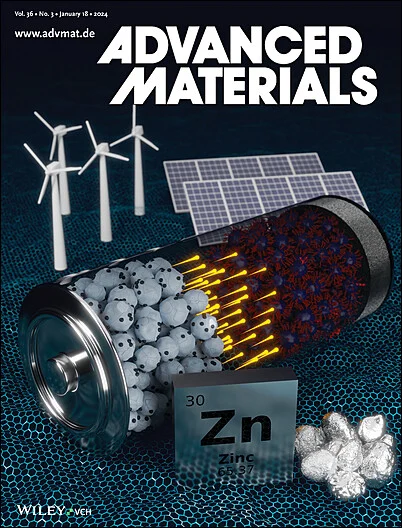揭示熔盐铝硫电池中硫转化动力学的催化模式。
IF 26.8
1区 材料科学
Q1 CHEMISTRY, MULTIDISCIPLINARY
引用次数: 0
摘要
在亚沸水温度下工作的熔盐铝硫(MSAS)电池由于其低成本和中等能量密度而对大规模储能具有吸引力。然而,硫正极受到多硫化物反应动力学缓慢的困扰,影响了其速率和循环性能。本文以碳材料集成单原子催化剂(SACs)作为MSAS电池的模型硫宿主,全面研究了这些SACs的活性模式对电池性能的影响。结果表明,该电池在0.5℃下的初始比容量为1064 mA h g-1,循环100次后容量保持在88.5%。即使在3C时,电池也能达到533 mA h g-1的比容量,并在6000次循环中表现出创纪录的长周期性能,每次循环的超低容量衰减率仅为0.0014%。通过结合理论计算和实验表征,揭示了一种新的机制,其中由于不同的al -聚硫化物的不同结合,钴- sac调节了长链到短链多硫化物的转化,同时加速了从短链多硫化物到固体Al2S3的转化。该机制减轻了熔盐电解质中多硫化物的积聚,减轻了穿梭效应,提高了硫的整体反应动力学。本文章由计算机程序翻译,如有差异,请以英文原文为准。
Revealing the Catalysis Modes for Sulfur Conversion Kinetics in Molten Salt Aluminum-Sulfur Batteries.
Molten salt aluminum-sulfur (MSAS) batteries operated at a sub-water-boiling temperature are attractive for large-scale energy storage because of the low costs along with moderate energy density. However, the sulfur positive electrode is plagued by the sluggish reaction kinetics of polysulfides, which hampers the rate and cycling performance. Herein, carbon materials integrated with single-atom catalysts (SACs) are utilized as the model sulfur hosts for MSAS batteries and comprehensively investigate the active modes of these SACs on cell performance. Results show that the cell utilizing cobalt-SACs shows an initial specific capacity of 1064 mA h g-1 at 0.5C, retaining 88.5% capacity after 100 cycles. Even at 3C, the cell achieves a specific capacity of 533 mA h g-1 and demonstrates record-long cycle performance with an ultralow capacity decay rate of only 0.0014% per cycle over 6000 cycles. By combining theoretical calculations and experimental characterizations, a new mechanism is undercovered wherein - owed to differentiated binding toward varied Al-polysulfides - the cobalt-SAC tunes down the conversion of long-chain to short-chain polysulfides while accelerating that from short-chain polysulfides to solid Al2S3. This mechanism alleviates polysulfide accumulation in the molten salt electrolyte, mitigates the shuttle effect, and enhances the overall sulfur reaction kinetics.
求助全文
通过发布文献求助,成功后即可免费获取论文全文。
去求助
来源期刊

Advanced Materials
工程技术-材料科学:综合
CiteScore
43.00
自引率
4.10%
发文量
2182
审稿时长
2 months
期刊介绍:
Advanced Materials, one of the world's most prestigious journals and the foundation of the Advanced portfolio, is the home of choice for best-in-class materials science for more than 30 years. Following this fast-growing and interdisciplinary field, we are considering and publishing the most important discoveries on any and all materials from materials scientists, chemists, physicists, engineers as well as health and life scientists and bringing you the latest results and trends in modern materials-related research every week.
 求助内容:
求助内容: 应助结果提醒方式:
应助结果提醒方式:


